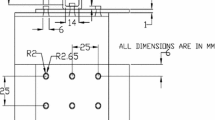Abstract
Press bending is widely used in Al integral panels for the aerospace industry, which, combined with multi-point dies, is an innovative approach. In the forming process, the fracture on integral panels is a fatal flaw. In this study, it mainly presents a core method on how to predict fracture on stiffeners by a novel method—the multi-point press bending. With the combination of a multi-point press bending experiment and corresponding finite element method (FEM) simulation, a suitable ductile criterion was selected to predict fracture on an aircraft Al stiffener. Using the fracture criterion, the fracture moments and fracture positions on stiffeners were determined in the multi-point press bending process. Due to the rapid reconfigurable characteristic of multi-point die, an optimal deformation path was discussed to reduce the fracture risk on stiffeners. It was identified that the Cockcroft criterion proved to be the most favorable ductile fracture criterion to predict fracture on stiffeners. Moreover, in the multi-point press bending process of the 7B04-T7451 Al stiffener, it is not prone to fracture with the increase of forming steps. Multi-point forming with an equidifferent curvature deformation path reduces the fracture risk of stiffeners much more than that with an equidifferent radius deformation path.
Similar content being viewed by others
References
Saadat M, Cretin L, Sim R, Najafi F (2009) Deformation analysis of large aerospace components during assembly. Int J Adv Manuf Technol 41:145–155. doi:10.1007/s00170-008-1464-y
Liu CG, Li MZ, Fu WZ (2008) Principles and apparatus of multi-point forming for sheet metal. Int J Adv Manuf Technol 35:1227–1233. doi:10.1007/s00170-006-0802-1
Cai ZY, Wang SH, Li MZ (2008) Numerical investigation of multi-point forming process for sheet metal: wrinkling, dimpling and springback. Int J Adv Manuf Technol 37:927–936. doi:10.1007/s00170-007-1045-5
Gurson AL (1977) Continuum theory of ductile rapture by void nucleation and growth: part I-yield criteria and flow rules for porous ductile media. J Eng Mater Technol 99:2–15. doi:10.1115/1.3443401
Rudnicki JW, Rice JR (1975) Conditions for the localization of deformation in pressure-sensitive dilatant materials. J Mech Phys Solids 23:371–394. doi:10.1016/0022-5096(75)90001-0
Ahmad R, Saeed A, Anoushiravan F, Nilgoon I (2009) Investigation of the viscous and thermal effects on ductile fracture in sheet metal blanking process. Int J Adv Manuf Technol 45(5):459–469. doi:10.1007/s00170-009-1988-9
Dilmec M, Halkaci HS, Ozturk F, Livatyali H, Yigit O (2013) Effects of sheet thickness and anisotropy on forming limit curves of AA2024-T4. Int J Adv Manuf Technol 67:2689–2700. doi:10.1007/s00170-012-4684-0
Safari M, Hosseinipour SJ, Azodi HD (2011) Experimental and numerical analysis of forming limit diagram (FLD) and forming limit stress diagram (FLSD). Mater Sci Appl 2:497–503. doi:10.4236/msa.2011.25067
Safikhani AR, Hashemi R, Assempour A (2008) The strain gradient approach for determination of forming limit stress and strain diagrams. Proceedings of the Institution of Mechanical Engineers Part B Journal of Engineering Manufacture 222:467–483. doi:10.1243/09544054JEM1025
Yan Y, Wang HB, Wang M (2011) Prediction of fracture in press bend forming of aluminum alloy high-stiffener integral panels. Comput Mater Sci 50:2232–2244. doi:10.1016/j.commatsci.2011.02.034
Wu S, Liang H (1990) A kinetic equation for ductile damage at large plastic strain. J Mater Process Technol 21(3):295–302. doi:10.1016/0924-0136(90)90049-Z
Yu ZQ, Yang YY, Wang YZ, Sun ZZ (2003) Application of ductile fracture criterion to predict of forming limit in aluminum alloy sheet forming. Chin J Nonferrous Metals 13(5):1223–1226
Kim J, Kim SW, Park HJ, Kang BS (2005) A prediction of bursting failure in tube hydroforming process based on plastic instability. Int J Adv Manuf Technol 27(5):518–524. doi:10.1007/s00170-004-2204-6
Lei LP, Kang BS, Kang SJ (2001) Prediction of the formimg limit in hydroforming processes using the finite element method and a ductile fracture criterion. J Mater Process Technol 113(1–3):673–679. doi:10.1016/S0924-0136(01)00694-X
Cai ZY, Li MZ (2001) Optimum path forming technique for sheet metal and its realization in multi-point forming. J Mater Process Technol 110:136–141. doi:10.1016/S0924-0136(00)00837-2
Thompson AW (1979) Discussion of “the mechanism of ductile intergranular fracture”. Scr Metall 13:329–330. doi:10.1016/0036-9748(79)90217-5
Cockroft MG, Latham DJ (1968) Ductility and workability of metals. J Inst Met 96:33–39
McClintock FA (1968) A criterion for ductile fracture by the growth of holes. J Appl Mech 35:363–371. doi:10.1115/1.3601204
Ayada M, Higashino T, Mori K (1984) Central bursting in extrusion of inhomogeneous materials. In: Proceedings of the Second International Conference on Technology of Plasticity, Advanced Technology of Plasticity. Stuttgart, pp 553–558
Rice JR, Tracey DM (1969) On the ductile enlargement of voids in triaxial stress fields. J Mech Phys Solids 17:201–217. doi:10.1016/0022-5096(69)90033-7
Brozzo P, Deluca B, Rendina R (1972) In: Proceedings of the International deep drawing research group on sheet metal forming and formability, October, Amsterdam
Oyane M, Sato T, Okimoto K, Shima S (1980) Criteria for ductile fracture and their applications. J Mech Work Technol 4:65–81. doi:10.1016/0378-3804(80)90006-6
Yan Y, Wang HB, Wan M (2012) Forming path optimization for press bending of aluminum alloy aircraft integral panel. J Shanghai Jiaotong Univ (Science) 17:635–642. doi:10.1007/s12204-012-1336-3
Li L, Seo YH, Heo SC, Kang BS, Kim J (2010) Numerical simulations on reducing the unloading springback with multi-step multi-point forming technology. Int J Adv Manuf Technol 48:45–61. doi:10.1007/s00170-009-2290-6
Achouri M, Gildemyn E, Germain G, Santo PD, Potiron A (2014) Influence of the edge rounding process on the behaviour of blanked parts: numerical predictions with experimental correlation. Int J Adv Manuf Technol 71:1019–1032. doi:10.1007/s00170-013-5522-8
Author information
Authors and Affiliations
Corresponding author
Electronic supplementary material
ESM 1
(PDF 901 kb)
Rights and permissions
About this article
Cite this article
Liu, Cg., Li, J., Dong, Yn. et al. Fracture prediction in the forming of aircraft Al stiffeners using multi-point dies. Int J Adv Manuf Technol 90, 3109–3118 (2017). https://doi.org/10.1007/s00170-016-9634-9
Received:
Accepted:
Published:
Issue Date:
DOI: https://doi.org/10.1007/s00170-016-9634-9




